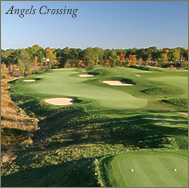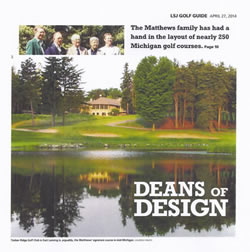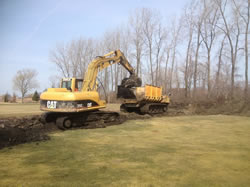
I come from a family background steeped in golf. My dad managed the family-owned Grand Haven Golf Club located behind the sand dunes of the Lake Michigan shoreline. The course offered my siblings, cousins and me an opportunity to learn to work at an early age. My career started with cleaning clubs, picking the range, filling pop machines, sweeping and cleaning during the summers. Soon I was working the counter and helping my dad grill steaks for outings. When I was fourteen I was able to work on the grounds crew. Roger Barton, whose brilliance is sometimes lost in his easygoing manner, was the superintendent. I have always admired his management of grasses and people. I still seek his advice and approval in my design business. Golf course architecture involves many disciplines; an important one is the ability to communicate technical knowledge in layman terms to get a job done well. Roger taught me this discipline. My granddad’s design philosophy was “design for the masses.” The average golfer, the majority of a course’s income source, should not be punished with undue hardships through the round. My granddad never built a fairway bunker. That’s not to say sand didn’t flank the fairways, as many of his courses were built through the sandy soils of western and northern Michigan. He was concerned about the owner making a profit. He was a very good router and the minimalist designs took full advantage of the existing features. My uncle Jerry worked with my granddad as his associate designer from 1960-1988 until illness required my granddad to step aside. Jerry has a Masters in Urban Planning and he is a very good conceptual designer. I worked for my granddad and Jerry for two years and for Jerry another three years after my granddad’s illness.
|
The Matthews family has been immersed in all facets of the game for golf for ninety years. The family history was highlighted by a nice article in the Lansing State Journal recently.
Watermark Country Club, Grand Rapids has expanded the clubhouse and outdoor special use area to meet demands of the members and patrons. The short game area, waterfalls and formal event area project is being overseen by superintendent, Steve Tedhams.
Rochester Place Golf Club, Belle River, Ontario was recently purchased by Paul St. Pierre. He has major plans for the course increasing the challenge for the better golfer with a greater variety of shot values. The planned renovations also incorporate the changing golf trends as the casual golfer is provided a highly valued experience. With an eye to the future, the construction is guided by Guy St Pierre.
|


 My granddad, a Stiles and VanKleek prodigy,
lived down the road from my childhood home. He was friends and worked with early icons of modern golf: Walter
Hagen, golf professional; O.J. Noer, scientist; Tom Mascaro, equipment inventor.
I met a lot of his friends and caddied for a couple of them. I rode with
my granddad on a couple of trips to his golf course projects under construction. I
liked his lifestyle and enjoyed his stories. I wanted to
be a golf course architect.
My granddad, a Stiles and VanKleek prodigy,
lived down the road from my childhood home. He was friends and worked with early icons of modern golf: Walter
Hagen, golf professional; O.J. Noer, scientist; Tom Mascaro, equipment inventor.
I met a lot of his friends and caddied for a couple of them. I rode with
my granddad on a couple of trips to his golf course projects under construction. I
liked his lifestyle and enjoyed his stories. I wanted to
be a golf course architect. My dad, manager
of Grand Haven Golf Club for 37 years, would have been just as
happy managing a hunt or fish club for the same period of time. My dad spent hours studying
hunting and fishing techniques. He could not wait for his passion, hunting
season, putting into practice his studies of finding game. He can
read the land as well or better than his dad. Reading the land, topography,
vegetation, is a given gift in golf course design. If you don’t have
it, it is extremely difficult to learn. The pure function of a golf course
is dependent on a designer’s ability to meld the game and the site. My
dad gave me the gift of “reading the land.”
My dad, manager
of Grand Haven Golf Club for 37 years, would have been just as
happy managing a hunt or fish club for the same period of time. My dad spent hours studying
hunting and fishing techniques. He could not wait for his passion, hunting
season, putting into practice his studies of finding game. He can
read the land as well or better than his dad. Reading the land, topography,
vegetation, is a given gift in golf course design. If you don’t have
it, it is extremely difficult to learn. The pure function of a golf course
is dependent on a designer’s ability to meld the game and the site. My
dad gave me the gift of “reading the land.”

